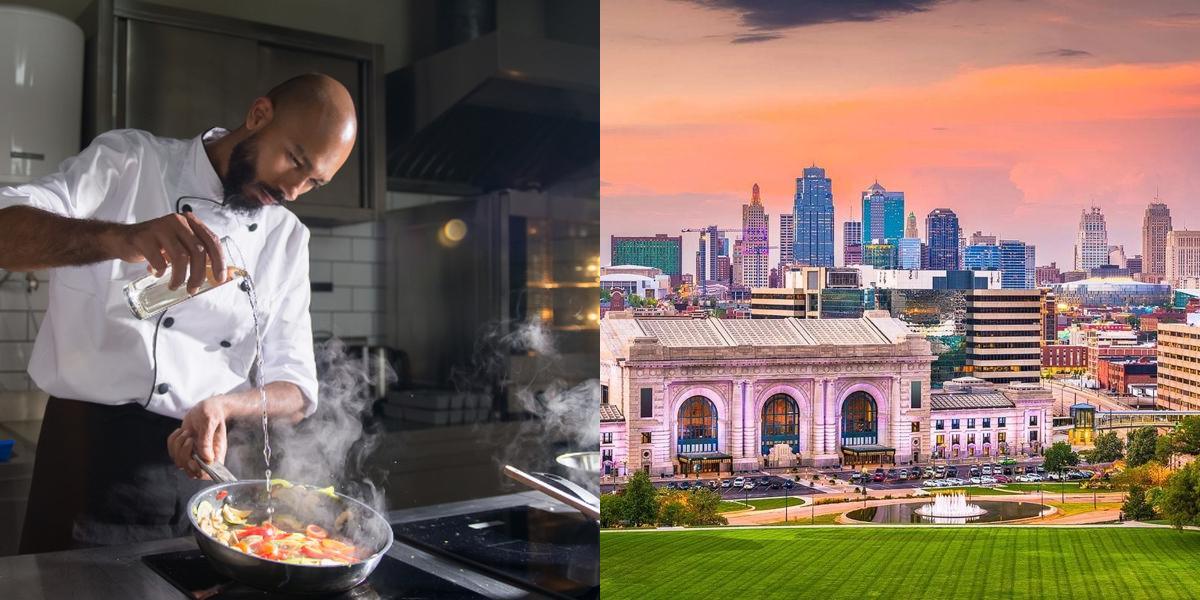How to Become a Chef in Missouri

Are you passionate about food and dream of becoming a chef? If you're in Missouri, you're in luck! This article will guide you through the process of becoming a chef in Missouri and provide you with information on where to find culinary arts classes.
How do I get My Culinary Arts Certification?
If you have a passion for cooking and want to pursue a career in the culinary arts, getting a culinary arts certification is a great way to start. This certification not only provides you with the necessary skills and knowledge but also demonstrates your commitment and expertise in the field.
To obtain your culinary arts certification, you can follow these steps:
-
Research Culinary Arts Programs: Start by researching culinary arts programs in your area or online. Look for accredited schools or institutions that offer comprehensive culinary arts programs. Consider factors such as program duration, curriculum, cost, and reputation.
-
Choose a Culinary Arts Program: Once you have a list of potential culinary arts programs, carefully evaluate each one. Look for programs that align with your career goals and provide the necessary training and education. Consider factors such as the program's focus (e.g., pastry arts, culinary management), class sizes, faculty qualifications, and facilities.
-
Apply to Culinary Arts Program: After selecting a culinary arts program, complete the application process. This typically involves submitting an application form, transcripts or GED scores, and any required essays or personal statements. Some programs may also require a culinary aptitude test or an interview.
-
Complete Culinary Arts Program: Once accepted into a culinary arts program, you will need to complete the required coursework and practical training. The duration of the program can vary depending on the level of certification you are pursuing. For example, a certificate program may take several months to a year, while an associate's degree program may take two years.
During your culinary arts program, you will learn various culinary techniques, food safety and sanitation, nutrition, menu planning, and kitchen management. You will also gain hands-on experience in a professional kitchen setting through internships or externships.
-
Obtain ServSafe Certification: ServSafe certification is a nationally recognized food safety certification that is highly valued in the culinary industry. Many culinary arts programs include ServSafe training as part of their curriculum. If your program does not offer it, you can take the ServSafe exam separately.
-
Gain Work Experience: While completing your culinary arts program, it's essential to gain practical work experience in the industry. This can be done through internships, externships, or part-time jobs at restaurants or catering companies. The hands-on experience will not only enhance your skills but also provide you with valuable industry connections.
-
Take Certification Exam: Once you have completed your culinary arts program and gained sufficient work experience, you can take the certification exam. The American Culinary Federation (ACF) offers various certification levels, such as Certified Culinarian, Certified Sous Chef, and Certified Executive Chef. The exams typically consist of both written and practical components.
-
Continuing Education: Culinary arts is a field that is constantly evolving, so it's essential to stay updated with the latest trends and techniques. Consider pursuing additional certifications or attending workshops and seminars to further enhance your skills and knowledge.
How Do I Get a Job as a Culinary Arts?
After obtaining your culinary arts certification, you may wonder how to get a job in the culinary arts industry. Here are a few steps to help you kickstart your culinary career:
-
Create a Professional Resume: Start by creating a professional resume that highlights your culinary education, certifications, work experience, and relevant skills. Tailor your resume to the specific job you are applying for, focusing on your culinary expertise and any specialties you have developed.
-
Develop a Portfolio: A culinary portfolio is a great way to showcase your culinary skills and creativity. Include photos or descriptions of dishes you have prepared, menus you have created, and any special events you have catered. This will give potential employers a visual representation of your work.
-
Network: Networking is crucial in the culinary industry, as it can lead to job opportunities and valuable connections. Attend industry events, join professional associations such as the American Culinary Federation (ACF), and connect with chefs and industry professionals on social media platforms like LinkedIn.
-
Apply for Jobs: Start searching for job openings at restaurants, hotels, catering companies, or other food service establishments. Look for positions that align with your career goals and offer opportunities for growth and advancement. Submit your resume and cover letter, highlighting your culinary qualifications and why you are interested in the position.
-
Prepare for Interviews: If you are invited for an interview, it's essential to prepare beforehand. Research the company or establishment and familiarize yourself with their menu, culinary style, and values. Practice answering common interview questions and be prepared to showcase your culinary skills if requested.
-
Gain Experience: If you are just starting your culinary career, you may need to gain additional experience before landing your dream job. Consider starting with entry-level positions such as line cook, prep cook, or kitchen assistant. This will allow you to learn from experienced chefs and gain practical experience in a professional kitchen setting.
-
Be Open to Learning: Culinary arts is a continuous learning process, so be open to learning from others and expanding your culinary knowledge. Take advantage of any training or development opportunities offered by your employer and seek feedback from more experienced chefs.
-
Stay Updated with Industry Trends: The culinary industry is constantly evolving, with new food trends and techniques emerging. Stay updated with the latest industry trends by reading culinary magazines, following food blogs, and attending culinary conferences or workshops. This will demonstrate your passion for the culinary arts and make you a more valuable asset to potential employers.
Career Paths and Opportunities after Becoming a Culinary Arts
Becoming a culinary arts professional opens up a world of career opportunities. Here are some career paths and opportunities you can explore after obtaining your culinary arts certification:
-
Chef or Cook: The most common career path for culinary arts graduates is working as a chef or cook. You can start as a line cook or prep cook and work your way up to positions such as sous chef, executive chef, or head chef. Chefs are responsible for creating menus, overseeing kitchen operations, managing staff, and ensuring food quality and consistency.
-
Catering: Many culinary arts professionals find rewarding careers in catering. Catering involves preparing and serving food for events such as weddings, corporate functions, or private parties. As a caterer, you will need to have excellent organizational and time management skills, as well as the ability to create menus that cater to different dietary preferences and allergies.
-
Pastry Chef: If you have a passion for baking and pastry arts, you can specialize as a pastry chef. Pastry chefs are responsible for creating a variety of desserts, bread, and pastries. This career path requires precision and creativity, as well as knowledge of baking techniques, flavor combinations, and presentation.
-
Food Stylist: Food styling is a unique career path that combines culinary skills with art and photography. Food stylists are responsible for making food look visually appealing for various media, such as cookbooks, magazines, advertisements, and commercials. This career requires creativity, attention to detail, and knowledge of food presentation techniques.
-
Food Writer or Blogger: If you have a passion for writing and culinary arts, you can pursue a career as a food writer or blogger. Food writers and bloggers create content related to food, such as recipes, restaurant reviews, cooking tips, and culinary trends. This career path allows you to share your culinary expertise and creativity with a wider audience.
-
Culinary Educator: Some culinary arts professionals choose to share their knowledge and passion by becoming culinary educators. This career path involves teaching culinary arts courses at culinary schools, community colleges, or vocational schools. Culinary educators not only teach culinary techniques but also mentor and inspire future culinary professionals.
-
Food Entrepreneur: With your culinary arts certification, you have the skills and knowledge to start your own food-related business. This can range from opening a restaurant or bakery to starting a food truck or catering company. Being a food entrepreneur requires not only culinary expertise but also business acumen, creativity, and perseverance.
-
Research and Development Chef: Research and development (R&D) chefs work in food manufacturing or food service companies, developing new recipes, products, or menu items. This career path involves experimenting with ingredients, flavors, and cooking techniques to create innovative and marketable food products.
How Much does a Chef make?
The salary of a chef can vary depending on several factors, including experience, location, and the type of establishment they work in. On average, chefs in the United States earn a median annual salary of around $51,530, according to the Bureau of Labor Statistics. However, starting salaries for entry-level chefs can be lower, typically ranging from $25,000 to $35,000 per year.
It's important to note that these figures are just averages, and individual salaries can vary significantly. Experienced and well-known chefs who work in high-end restaurants or run their own establishments can earn six-figure salaries or even more.
Final Thoughts
Obtaining a culinary arts certification is the first step toward a fulfilling career in the culinary industry. It provides you with the necessary skills, knowledge, and credibility to succeed in various culinary roles. Whether you dream of becoming a chef, starting your own business, or exploring unique culinary career paths, the culinary arts certification opens up a world of opportunities. Remember to continue learning, gaining experience, and staying updated with industry trends to excel in your culinary career. So, take the leap and embark on your journey to becoming a culinary arts professional today.
Dreambound offers a window into various career paths, so if you're considering a shift in your career, browse through these articles:





